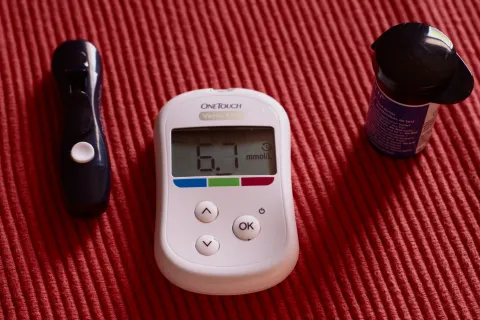Autism and hospital visits
How to help your child cope with an inpatient hospital stay
By Angeles NunezThis answer by Angeles Nunez, a certified child life specialist at Wolfson Children’s Hospital in Jacksonville, Florida.
My child needs to be admitted to the hospital. How can I help them cope with an inpatient stay? How can I explain their needs to the staff?
This is a common concern for families with a child that needs to go to the hospital.
Taking your autistic child to the hospital
Upon arriving to the hospital — whether it is through the emergency department or through a planned admission stay — it is important to notify staff of your child’s abilities and how to best provide care for them. Some ways to do that can include:
- Use an “All About Me” information sheet. Upon notification, some hospitals have a form that can help communicate to hospital staff how to best help your child. You can also make your own based on this Autism Care Questionnaire, or use the attached example. You can use an All About Me sheet or binder for any interaction where others may need to learn about your child. Information to include may be how to best communicate with your child, any tools your child uses at home (such as a first-then board or visual schedule), your child’s likes and dislikes, and any triggers or sensitivities such as loud noises or certain colors and how to accommodate them.
- If your child or family member has significant communication challenges, bring any communication support tools they use and make sure hospital staff know how to use them. Describe what attempts at communication look like for them. For those with little or no speech, this will be particularly important.
- Likewise, if your child has any behaviors that could potentially be challenging during a medical procedure or at other times during a hospital stay, be sure the staff understand how the behavior typically appears and how you usually manage it. You may need to work together with the staff to adapt the plan in the hospital setting.
- Talk with your child’s caregivers. Hospital staff manage many patients at once, so be sure to meet your child’s nurses, case manager, doctors and any other providers each time there is a change in staffing. Generally, this happens twice a day. Ask to have your All About Me sheet included in your child’s chart, but also make sure to review it with each new staff member. They may not have time to read it thoroughly before meeting your child, so it will help them do their best to provide your child supportive care.
- Request child life services. A child life specialist helps children cope with the stressors of being in the hospital and can provide preparation, support and education before, during and after medical procedures. Child life specialists can also provide play and relaxation activities to create a more normalized environment to help children in the hospital better understand their surroundings and to help them gain a sense of control.
- Ask for family presence during procedures. Research shows that by providing a comfortable environment and by allowing family presence during painful procedures, a child’s overall distress and anxiety decrease. You know how to best support your child, and you can advocate to be present during any situation that may be stressful for your child.
- Pack a comfort bag. Pack a bag prepared with your child’s favorite toys or comfort items. Items you may want to include are: family photos, a stuffed animal, favorite outfit, a jacket or blanket, or a preferred snack.
Inpatient stay
If your child has a hospital admission planned, prepare ahead of time. If possible, bring your child to the hospital to become familiar with the surroundings and take advantage of tours the hospital may offer. Talk to staff ahead of time and ask if there are any staff members who can meet your child prior to the visit. This will help to make the hospital stay less scary. The hospital website may also be helpful in preparing for your child’s visit. Some children’s hospitals provide hospital stories — similar to social stories — in which information and pictures are shown to describe basic hospital procedures or routines. Ask if your hospital has one available.
Role-play with medical tools can also prepare your child for a trip to the hospital. Help your child understand their experiences and become more comfortable with equipment by playing pretend. Use a stuffed animal and a play doctor’s kit to allow your child to become familiar. Practice using a stethoscope or using band-aids on the stuffed animal and yourself. Show your child the purpose of these items and gradually build up to the child practicing on themselves. Gradual, step-by-step direction and exposure is best, allowing the child to become comfortable.
Behavioral health stay
When your child is admitted to a behavioral health unit, the admission can be very different from a typical medical hospital admission. Continue to notify staff of your child’s abilities and any behaviors your child may have, including self-injury or aggressive behaviors. Inform new staff members who join your child’s care team during your stay.
- Item restrictions: Ask about materials that are and are not allowed on the unit. Typically, electronics and items that are metal or have loose string are not allowed on the unit for safety reasons. Provide your child with comfort items, such as your child’s favorite stuffed animal, blanket or pillow, once you check with the staff.
- Visitation hours: Visitation hours on the unit are often at set times during the day. Speak to staff about the possibility of separate visitation hours to help your child transition during a less busy time away from peers and other families. Ask if visitation time can be in the child’s assigned room where they may already be comfortable.
- Meals: Tell staff about the foods your child prefers for breakfast, lunch and dinner. Ask if you can build your child’s food menu for the day. If your child only eats specific foods, specific brands or has a special diet, talk to staff about bringing food in for your child.
How to help your child cope in the hospital
Fast-paced hospital environments can be difficult to navigate when there are factors out of our control. Wait times and sensory stimuli such as noises or smells can be overwhelming. Continue to keep your child informed, and use visual and auditory formats to help your child understand their surroundings and what is happening. Use realistic first-then statements, for example: “First we sit down [for your wait in waiting room], then we eat a snack,” and offer your child’s preferred snack. Take each action one step at a time, allowing your child to see the first and then within a reasonable time frame. Relaxation techniques can also help your child remain calm throughout the stay and throughout any procedures or interactions with staff.
- Practice breathing exercises. Practice holding and releasing breath using a pinwheel or bubbles. This technique can also be beneficial when helping your child cope during basic procedures, such as blood pressure readings or other vital signs checks.
- Use sensory items. Sensory items can help to calm your child, distract them from becoming overwhelmed and help them to focus on one thing. Use a ball of Play-Doh, a stress ball, slime or putty to help your child squish, squeeze and release their overwhelming emotions.
- Visualize a happier place together. Using guided imagery techniques, encourage your child to imagine a happier place, thinking about the sights, sounds and smells of that place. Use pictures or items to help the visualization process. For example, to help remember that time at the aquarium where you saw the fish that looked like Nemo and Dory, select a fish toy that you can show your child to help bring that experience to mind.
*If your child has substantial communication challenges, some of the above suggestions may not apply or may need modification to be useful. Communicate to your health care team in advance about your child’s support needs and how to best prepare in a personalized way.









